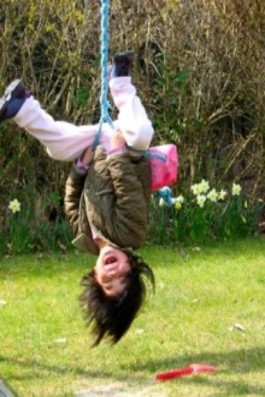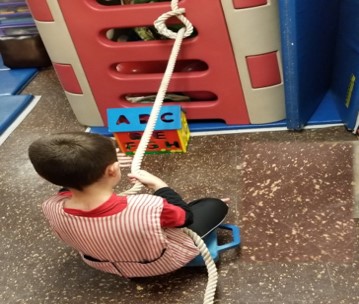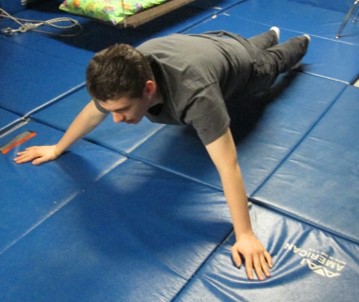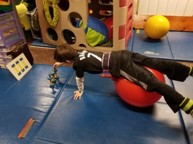Key Issue: Level of Arousal
The Over-Aroused Child
Setting up home program activities for children who have difficulties with self regulation and sensory issues can be a challenge. Many children who have these issues show a variable sense of what is “just right” in terms of attention, social skills, excitement and readiness to join in activities. When brought together as a group, these issues are jointly called “arousal”.
Home programs for children who have difficulties with self-regulation need to address several strategies. For example, while swinging can be a helpful activity, the youngster shown below has taken swinging to a new level

This over-aroused boy has chosen to add hanging upside down for additional stimulation. His wide-open mouth shows that he is also using a loud voice while he swings.
The drive to add arousing movements to traditional activities is somewhat typical for children who tend to be over-aroused. Self regulation for this youngster is problematic.
In a similar manner, dancing can be a helpful activity. But dancing with headphones is not enough for this youngster who has chosen to bounce on her bed while she pushes her arms up and sings along to add more input. The drive to add arousing movements to traditional activities is somewhat typical for children who tend to be over-aroused. This can make home programs problematic since activities with too much energy often do not end well.

Symptoms of being over-aroused often include:
- Overactivity
- Tendency to be “on the go”
- Excessive talking
- Difficulty pacing an activity
- Difficulty with attention
- Use of excessive force
Occupational Therapists have shown that when home programs that incorporate “heavy work” are used throughout the day, these children are better able to regulate themselves. A surprising feature of “heavy work” is that these strategies work equally well with children who are over-aroused as well as with those who are under-aroused.
Surprisingly, over-aroused children who have issues with self-regulation can easily fluctuate from being over-active and noisy to being momentarily calm and quiet. This is why home programs that use heavy work activities are helpful when the child flip-flops from one level of arousal to another.
Home programs that address issues of self regulation for children who are under-aroused incorporate key features of heavy work by presenting activities that include the key features.
Intentionally introduce key features
For example, begin with activities that incorporate quick movements, bright colors, firm manipulatives, a well inflated (therefore firmer) hop ball, forceful music for listening and moving.

Use Steady, antigravity activity such as Physioball walk outs. These children are lying on their tummies and walking forward on their hands to assemble a project. One is building a project of a block tower, while the other child is assembling a preschool puzzle.

Use resistive activities, such as pulling and pushing the weight of the whole-body against a stationary boundary can also be helpful.

This youngster is sitting on a scooter and pulling on a rope to bring letters to the alphabet house. 
This older boy is able to use push-ups for heavy work

Use regular, rhythmic body moves, for example using a hop ball while hopping along to the beat of steady music.

Over time, you will want to intentionally pull back in terms of intensity. You can use softer colors, softer more flexible toys, and a slower tempo for music used for listening and moving. This will help the child who is over-aroused learn to maintain a more typical pace as needed for attention and social interactions. For more suggestions please see our self regulation primer and this post on upper body strength. We also recommend you read about heavy work activities.



Comments are closed.